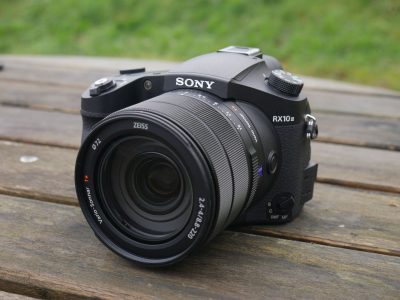Sony Cyber-shot RX10 III review
-
-
Written by Ken McMahon
Quality
Sony RX10 III vs Panasonic Lumix FZ2000 / FZ2500 JPEG quality results
To compare real-life performance, I shot this scene with the Sony RX10 III and the Panasonic Lumix FZ2000 / FZ2500 within a few moments of each other, using their best quality JPEG settings and at their base sensitivity settings. For this test the cameras were mounted on a tripod and image stabilisation was disabled. Both cameras were set to their 24mm equivalent maximum wide angle focal length.
I’d previously determined that best results were achieved at f4, so both cameras we’re set to Aperture priority mode and f4 selected. The Sony RX10 III was set to its base 100 ISO sensitivity setting and selected an exposure of 1/400. Also set to f4 and at its base 125 ISO sensitivity setting, the Lumix FZ2000 / FZ2500 metered an exposure of 1/320 – the same as the RX10 III given the different ISO sensitivity.
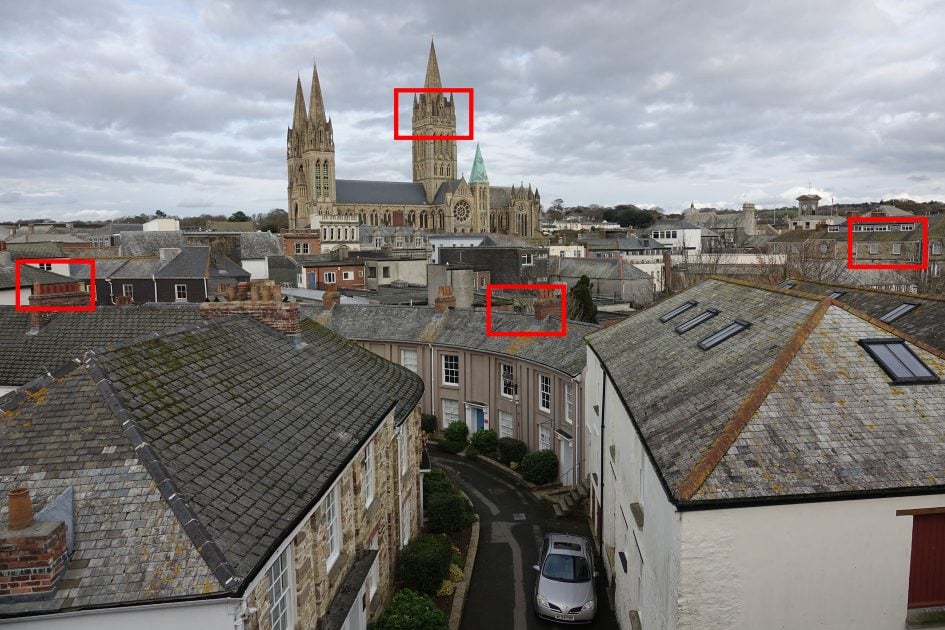
Both of these cameras share a 20 Megapixel resolution producing 3:2 images measuring 5472 x x3648 pixels so the crops areas and image detail are the same size. As usual the crops below are taken from the areas marked in red above..
Casting an eye down the left hand column the results from the Sony RX10 III look very promising. The first crop, from close to the left edge of the frame is a little fuzzy; there’s plenty of detail but those edges are clearly not as crisp and distinct as they could be. Move on to the second crop, though, and things improve considerably. The fuzziness is gone and the fine detail in the catherdal stonework is beautifully rendered. The detail gets even sharper in the third crop from right in the middle of the frame, before going slightly soft again in the crop from the right edge of the frame.
The crops from the Panasonic Lumix FZ2000 / FZ2500 fair similarly, they’re soft and a little fuzzy at the edges and sharper in the middle. But the difference between the quality at the edges and centre of the Lumix crops is greater and overall they’re not as detailed as those from the RX10 III. I think the RX10 III’s lens is outperforming the Lumix FZ2000 / FZ2500’s zoom at this wide angle setting, no mean feat considering its extra reach – 25x compared with 20x on the Lumix.
The question is, can the Sony lens maintain its advantage over the Lumix throughout its range? Scroll down to find out, or to find out how they compare at higher sensitivities head for my Sony RX10 III noise results, skip to my Sony RX10 III sample images, or head straight to my verdict.

Above left: Sony RX10 III f4, 100 ISO. Above right: Panasonic Lumix FZ2000 / FZ2500 f4, 125 ISO

Above left: Sony RX10 III f4, 100 ISO. Above right: Panasonic Lumix FZ2000 / FZ2500 f4, 125 ISO

Above left: Sony RX10 III f4, 100 ISO. Above right: Panasonic Lumix FZ2000 / FZ2500 f4, 125 ISO

Above left: Sony RX10 III f4, 100 ISO. Above right: Panasonic Lumix FZ2000 / FZ2500 f4, 125 ISO
Sony RX10 III quality at 200mm equivalent
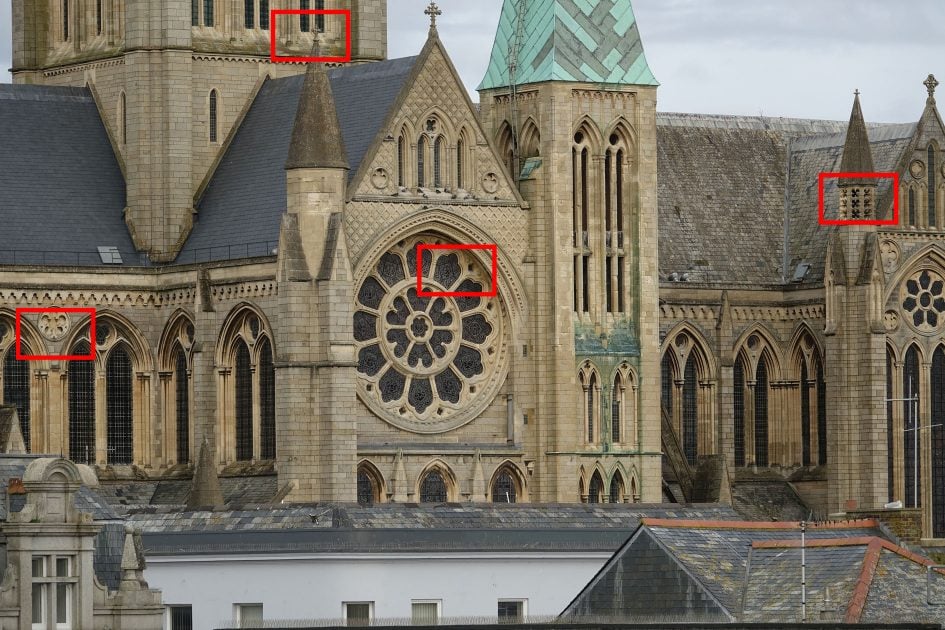
For this next test I zoomed both cameras in to roughly 200mm equivalent. At this focal length the Lumix FZ2000 / FZ2500 stops down to f4.5 but the RX10 III can maintain f4. So for this comparison I closed both lenses to f4.5. As before the crops below are taken from the areas marked in red above.
At this 200mm equivalent focal length, there’s a clear difference straight off between the Sony RX10 III and the Lumix FZ2000 / FZ2500. In the first crop from the left edge of the frame the RX10 III on the left is a lot cleaner and crisper. There’s a level of detail in the stonework in the RX10 III crop that just isn’t there in the FZ2000 / FZ2500 crop. The same is true of all the crops at this focal length, across the frame the Sony RX10 III produces crisper cleaner crops with more detail than those from the Lumix FZ2000 / FZ2500. What’s more, the difference in quality in the middle of the zoom range is more pronounced than at the wide angle setting.
Scroll down to see how they fair when zoomed to the FZ2000 / FZ2500’s maximum 480mm equivalent focal length.

Above left: Sony RX10 III f4.5, 100 ISO. Above right: Panasonic Lumix FZ2000 / FZ2500 JPEG f4.5, 125 ISO

Above left: Sony RX10 III f4.5, 100 ISO. Above right: Panasonic Lumix FZ2000 / FZ2500 JPEG f4.5, 125 ISO

Above left: Sony RX10 III f4.5, 100 ISO. Above right: Panasonic Lumix FZ2000 / FZ2500 JPEG f4.5, 125 ISO

Above left: Sony RX10 III f4.5, 100 ISO. Above right: Panasonic Lumix FZ2000 / FZ2500 JPEG f4.5, 125 ISO
Sony RX10 III quality at 480mm equivalent
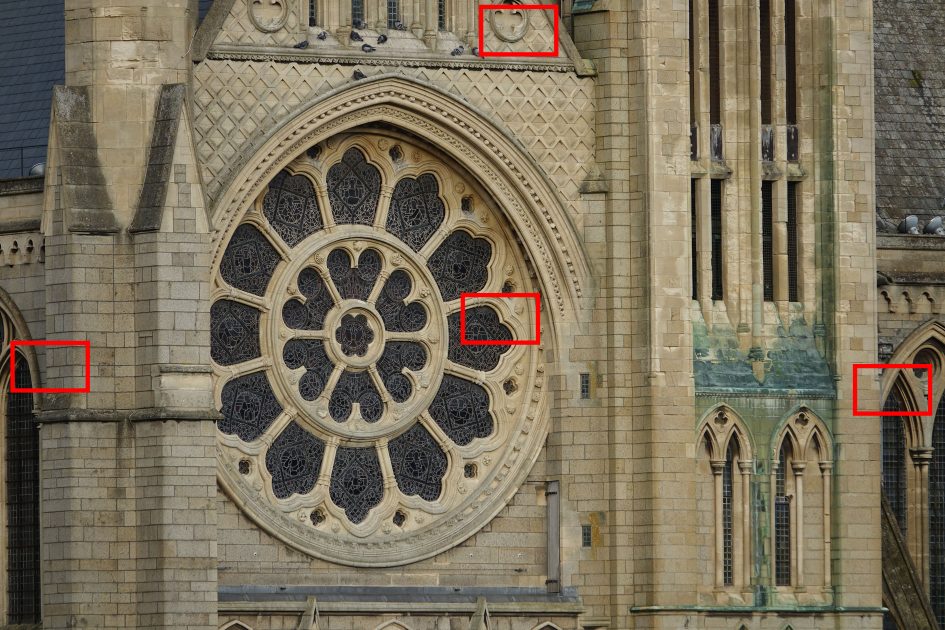
For this comparison I zoomed the Lumix FZ2000 / FZ2500 to its maximum 480mm equivalent focal length and zoomed the Sony RX10 III to match it. This is still a little way short of the Sony RX10 III’s maximum 600mm equivalent focal length which you can see in the final set of crops below these. As before the crops are from the areas marked in red above. And as before, the RX10 III does better across the frame, with all four crops showing sharper edges and better detail. Whichever way you look at it, it’s a pretty emphatic win for the Sony RX10 III.

Above left: Sony RX10 III f4.5, 100 ISO. Above right: Panasonic Lumix FZ2000 / FZ2500 f4.5, 125 ISO

Above left: Sony RX10 III f4.5, 100 ISO. Above right: Panasonic Lumix FZ2000 / FZ2500 f4.5, 125 ISO

Above left: Sony RX10 III f4.5, 100 ISO. Above right: Panasonic Lumix FZ2000 / FZ2500 f4.5, 125 ISO

Above left: Sony RX10 III f4.5, 100 ISO. Above right: Panasonic Lumix FZ2000 / FZ2500 f4.5, 125 ISO
Sony RX10 III quality at 600mm equivalent
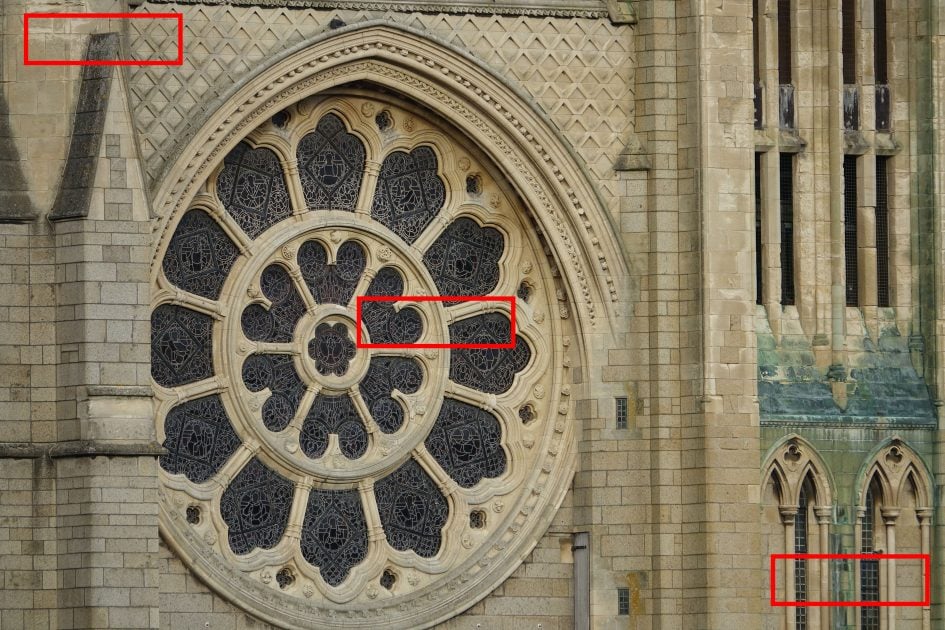
For this final set of crops I zoomed the Sony RX10 III all the way to its maximum 600mm equivalent focal length. The crops below are from the three areas marked in red above taken from the top left, centre, and bottom right of the frame. As at the wide angle setting there’s a visible difference between the image quality in the middle of the frame, which is excellent, and in the corners, which is merely pretty good. All in all this is a great set of results for the RX10 III’s zoom, which produces excellent results across the frame throughout the zoom range.

Above: Sony RX10 III f4.5, 100 ISO

Above: Sony RX10 III f4.5, 100 ISO

Above: Sony RX10 III f4.5, 100 ISO
Sony RX10 III vs Panasonic Lumix FZ2000 / FZ2500 JPEG noise results
To compare noise levels under real-life conditions, I shot this scene with the Sony RX10 III and the Panasonic Lumix FZ2000 / FZ2500 within a few moments of each other at each of their ISO settings. The cameras were set to their best quality JPEG modes and mounted on a tripod and stabilisation was disabled. I disabled DRO on the RX10 III as it can affect the noise characteristics of images shot in low light.
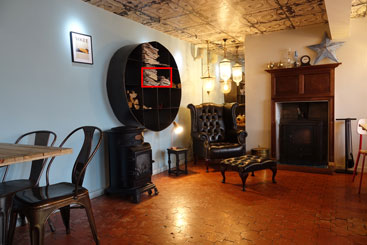
Both cameras were set to their 24mm equivalent maximum wide angle focal length. I’d previously determined that best results were achieved at f4, so both cameras we’re set to Aperture priority mode and f4 selected. Set to its 100 ISO base sensitivity the RX10 III chose an exposure of 0.6s and at its 125 ISO base sensitivity the Lumix FZ2000 / FZ2500 chose 0.5s – the same exposure as the RX10 III given the different ISO setting.
Both cameras have an extended ISO sensitivity range that can be activated from the menu. The RX10 III provides 64 and 80 ISO at the low end of the range and the Lumix FZ2000 / FZ2500 extends down to 80 ISO and has an additional 25600 ISO setting at the top. For the sake of completeness, and because it’s interesting to see the comparisons, I’ve included these additional settings in the table below, but bear in mind the important comparison is between the base ISO settings – 100 ISO for the RX10 III and 125 ISO for the Lumix FZ2000 / FZ2500.
Casting an eye down the left column of crops I think it’s fair to say that the Sony RX10 III puts in a pretty good noise performance for a 1 inch sensor. At the lower ISO settings and at the base 100 ISO there’s very little if any noise texture visible. As you move up the sensitivity scale of course the noise increases but it’s managed well with the result that up to 400 ISO you’d have to be pixel peeping these 100 percent crops to spot the difference. The noise is visible at 400 ISO, but it’s very fine-grained and isn’t reducing the image detail appreciably.
Likewise at 800 and 1600 ISO, despite the increase in noise the crops maintain a natural look with all but the very finest detail affected, but 3200 ISO is a bit of a watershed, and the point at which you can begin to see the noise without having to look for it. It’s worth pointing out that at smaller sizes 3200 ISO looks pretty respectable, beyond that it’s a real battle between the noise and image detail. Again though, worth pointing out that up to 12800 ISO you can get away with it at smaller sizes.
Compared with the crops from the Lumix FZ2000 / FZ2500, it’s too close to call. I’ve stared at these crops for a while and I can’t spot much of a difference at any of the sensitivity settings.

Above left: Sony RX10 III at 64 ISO. Above right: Panasonic Lumix FZ2000 / FZ2500 JPEG 64 ISO not available.

Above left: Sony RX10 III at 80 ISO. Above right: Panasonic Lumix FZ2000 / FZ2500 JPEG at 80 ISO.

Above left: Sony RX10 III at 100 ISO. Above right: Panasonic Lumix FZ2000 / FZ2500 JPEG at 100 ISO.

Above left: Sony RX10 III at 125 ISO. Above right: Panasonic Lumix FZ2000 / FZ2500 JPEG at 125 ISO.

Above left: Sony RX10 III at 200 ISO. Above right: Panasonic Lumix FZ2000 / FZ2500 JPEG at 200 ISO.

Above left: Sony RX10 III at 400 ISO. Above right: Panasonic Lumix FZ2000 / FZ2500 JPEG at 400 ISO.

Above left: Sony RX10 III at 800 ISO. Above right: Panasonic Lumix FZ2000 / FZ2500 JPEG at 800 ISO.

Above left: Sony RX10 III at 1600 ISO. Above right: Panasonic Lumix FZ2000 / FZ2500 JPEG at 1600 ISO.

Above left: Sony RX10 III at 3200 ISO. Above right: Panasonic Lumix FZ2000 / FZ2500 JPEG at 3200 ISO.

Above left: Sony RX10 III at 6400 ISO. Above right: Panasonic Lumix FZ2000 / FZ2500 JPEG at 6400 ISO.

Above left: Sony RX10 III at 12800 ISO. Above right: Panasonic Lumix FZ2000 / FZ2500 JPEG at 12800 ISO.

Above left: Sony RX10 III 25600 ISO not available. Above right: Panasonic Lumix FZ2000 / FZ2500 JPEG at 25600 ISO.
Check prices at Amazon, B&H, Adorama, eBay or Wex. Alternatively get yourself a copy of my In Camera book, an official Cameralabs T-shirt or mug, or treat me to a coffee! Thanks!




